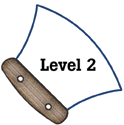
Alaska Science
Key Element A7
A student who meets the content standard should understand how the Earth changes because of plate tectonics, earthquakes, volcanoes, erosion and deposition, and living things (Processes that Shape the Earth).
 |
Alaska Science A student who meets the content standard should understand how the Earth changes because of plate tectonics, earthquakes, volcanoes, erosion and deposition, and living things (Processes that Shape the Earth). |
|
Performance Standard Level 2, Ages 8–10
|
|
|
|
Sample Assessment Ideas
|
|
|
Expanded Sample Assessment Idea
|
|
Procedure Students will:
Reflection and Revision
|
Levels of Performance |
||
|
Stage 4 |
Student work is complete, shows evidence of logical reasoning, and knowledge of changes in stream beds caused by moving water. Before and after diagrams are clearly labeled and contain multiple details of the stream table demonstration. | ||
|
Stage 3
|
Student work may contain minor errors or omissions but shows evidence of logical reasoning and knowledge of changes in the stream beds caused by moving water. Before and after diagrams are labeled and contain some details related to the stream table demonstration. | ||
|
Stage 2
|
Student work is incomplete, incorrect, lacks detail, may contain errors of science fact and reasoning, and shows limited evidence of knowledge of changes in the stream beds caused by moving water. Diagrams may show skilled artwork but limited information related to the stream table demonstration. | ||
|
Stage 1
|
Student work is mostly incomplete, incorrect, and contains errors of science fact and reasoning, and shows little or no evidence of knowledge of how moving water changes the steam beds. Diagrams may show skilled artwork, but do not describe the stream table demonstration. | ||
Standards Cross-References
|
||
|
National Science Education Standards The surface of the Earth changes. Some changes are due to slow processes, such as erosion and weathering, and some changes are due to rapid processes, such as landslides, volcanic eruptions, and earthquakes. (Page 134) Water, which covers the majority of the Earth’s surface, circulates through the crust, oceans, and atmosphere in what is known as the “water cycle.” Water evaporates from the Earth’s surface, rises and cools as it moves to higher elevations, condenses as rain or snow, and falls to the surface where it collects in lakes, oceans, soil, and in rocks underground. (Page 160) Living organisms have played many roles in the Earth system, including affecting the composition of the atmosphere, producing some types of rocks, and contributing to the weathering of rocks. (Page 160) |
Benchmarks Waves, wind, water and ice shape and reshape the Earth’s land surface by eroding rock and soil in some areas and depositing them in other areas, sometimes in seasonal layers. (Page 72) Rock is composed of different combinations of minerals. Smaller rocks come from the breakage and weathering of bedrock and larger rocks. Soil is made partly from weathered rock, partly from plant remains-and also contains many living organisms. (Page 72) |
|
Table of Contents | Return to Alaska Native Knowledge Network